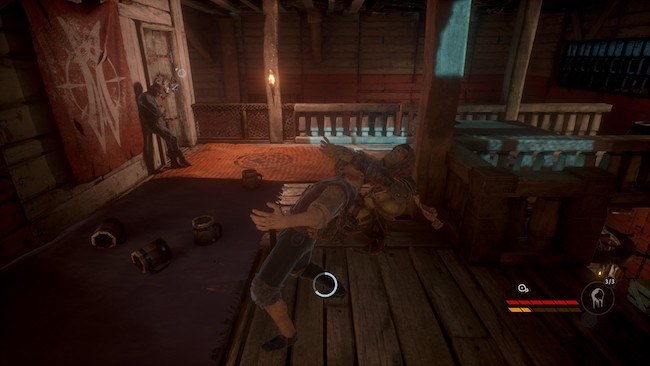
I have loved many stealth games in my life. Splinter Cell, Tenchu, Metal Gear and Hitman, to name a few. As time has worn on, a difficult-to-shake feeling has clung to my mindset when stalking armed guards and hiding corpses. Where the base appeal of brazen violence in shooters can be said to bring with it a certain earnestness, sticking to the shadows and preying on the unsuspecting is a suspiciously perverse joy. Being a meathead feels honest – stalking the unaware is a bit depraved. Styx: Shards of Darkness helped me learn to stop worrying and love the dagger, all the while goading me into rising to meet its devilish level of challenge. It was all that, along with more than a few goofy laughs to ease the pain of my frequent failure to meet said challenge. I’d never given much time to either of Shards of Darkness’ (SoD) forebears, Of Orcs and Men and Master of Shadows. What little I had played of the latter had left me rather underwhelmed with its finicky controls and drab colour palette. SoD is mostly free of these issues, and while not perfect, is a refreshingly tough sneak-em-up with an old school bent.
While I may have dabbled with the previous Styx game, I was none the wiser about the lore of SoD’s world or any of the events that precipitated the characters’ circumstances. That wasn’t much of a drawback I found, as the opening cinema gave me everything I needed to be sucked in. As we find him, Styx is skulking around the makeshift slums of Thoben. The dreary swamplands aren’t to the titular character’s liking, but it makes for a comfortable hiding place filled with easy marks to rob. Before long he’s swiftly leaping across rooftops, strangling guards and cracking wise about being the new accountant as he makes off with a chest full of gold. It’s not too long, however, before he’s forced into an uneasy alliance with the head guard of a goblin extermination squad. The journey they set out upon lands Styx right in the middle of a genocidal plot against his own kind, and there’s deceit, betrayal and plenty of cold-blooded murder involved.

The story beats offer enough entertainment value considering the generic nature of SoD’s medieval fantasy world. Its story doesn’t aim to enthral or challenge, but it does an impeccable job of giving its central character a platform to shine. Styx is quite the amicable scoundrel, and he hardly ever shuts up. If you’re a fan of Deadpool, you’ll find this grotty little greenskin will most likely have you laughing. When you die, he’ll wade through the shadows of death to address you directly with plenty of snide insults, complaints or even demand a percentage of your Twitch stream revenue. He’ll often make funny references to icons of gaming and pop culture, mostly in ridicule, and offer his foul-mouthed two cents on everything from the weather to the daily work habits of the Dark Elf elite guard. The humour is base, and more than a little coarse, but Styx lends more character to his game than it has any right to.
It works in SoD’s favour that Styx is so likeable, as the game’s difficulty can be downright harsh. I eventually found that this was an intentional part of the design philosophy, but only once I’d spent a handful of hours dying repeatedly. I get the feeling that the croissant chomping devs at Cyanide Studio are fans of the Souls series. The first two missions are particularly disorientating, and I put this down to the fact that the game’s tutorial only partially explains Styx’s abilities and controls. It wasn’t until the third mission that I decided to look up the key bindings and found out I could turn myself invisible. That small detail would have been mighty useful much earlier, possibly saving a handful of tantrums of the seemingly arbitrary level of difficulty. That being said, the controls themselves are as smooth as butter.

Styx may be small, but he’s a terribly nimble wee chap – he can mantle, dive roll and scale the walls of the environs he finds himself in with ease. The levels he’ll have to navigate are vast and semi-open, allowing for multiple paths of approach or escape. Where Styx differs from most modern stealth games is in Stx’s fragile nature and the level of punishment for slipping up. Where the likes of Metal Gear Solid or Splinter Cell cast you as heavily armed special force commandos, Styx is innately more susceptible brutalisation. With a height coming up at the average human’s knee, the little grub is a bit lacking in offensive and defensive ability. If caught, he can parry his attackers blade with a simple timing mechanic, but any of your foe’s buddies will be sure to know of it. SoD’s enemies are highly sensitive to sound, and when made aware of Styx’s presence will draw overwhelming numbers to their position. The best choice then is often to avoid violence unless your target is well and truly isolated. When it comes to assassination, Styx can either kill quickly but loudly, or slowly and silently. He can hide bodies in trunks or wardrobes, but only one at a time, so keeping the body count to a minimum is necessary for good housekeeping around the many patrols around each level.
Alternatively, you can pour some acid over the body and watch it evaporate. The acid, along with darts, amber (mana) and health potions make up the core tool-belt items players can craft. Styx can scavenge items for crafting from throughout a level (or eventually from corpses), which he can then, in turn, fabricate things with on sporadically placed workbenches. These benches are also available in pre-mission briefing areas, as are weapon/clothing wardrobes and skill benches. The AI’s level of readiness is ripe for exploitation once the player has invested in one of a handful of skill-trees. These offer both expected and unconventional upgrades, from death-from-above style executions to being able to craft acid traps. Most interestingly, Styx is capable of vomiting up clones of himself, and come replete with their own particular skill tree. These clones are useful for both reconnaissance and distractions, but once fully upgraded Styx can warp into a clone’s body for a short distance teleport.

All of Styx’s upgrades trickle through at a painfully slow pace, and you’re not likely to have more than a couple of fully upgraded trees by the end of it. Your greatest weapon, however, will always be the quicksave button. You will repeatedly die until you learn to wise up. I only ever felt like my deaths were my own stupid fault, though. In the same vein, time, mercy and alert trials are front and centre on the pause menu from the very start of the game. Should you fail to meet a quota, the game will show a pop-up to remind you. It doesn’t hesitate to judge you, but as I’ve said this only made me want to better my skills rather than get frustrated.
It’s this outright hostile difficulty curve that might be off-putting to some, and a few minor niggles could see one giving up on this little gem before they should. I cannot stress enough just how outright maddening the opening missions are. They’re cramped and seemingly stuffed with enemies, and they serve only to highlight the limited usefulness of Styx’s ‘amber vision’. This vision mode highlights objects like crafting items, hiding spots, climbable objects and potential noise hazards in various colours when activated. At no point can you see them through walls, so its actual usefulness is quite limited. After a few hours of play, you won’t need amber vision to know how to interact with the world, and the available upgrades for it don’t offer any significant changes. Your line of sight through the camera and your ears are your best sensory tools. While the controls felt good to me playing on a PC, I can imagine a need for greater sensitivity when controlling the camera on a gamepad, as it is vital for your level of awareness due the lack of wall-hacking vision modes.
Lastly, the death screen quips get old damned quick, but your itchy save finger will take care of that problem for you before long. Regardless of my gripes, the game was consistently gorgeous to look at. Unreal 4 tech is put to good use here, with stunning character models and atmospheric lighting that made the small fortune I should have spent on my child’s future (but ended up in my PC) seem worth it.

Styx: Shards of Darkness is a refreshingly obtuse stealth action game, with a snarky but endearing lead character and an old school difficulty curve. It might occasionally make you put your head through your keyboard, but once it gets going this game offers a sense of reward for its risky escapes and high-stakes kills unlike that of its contemporaries. The risk of employing tactics is high, but pulling it off will have your heart jumping like an over-amped Energiser bunny.











